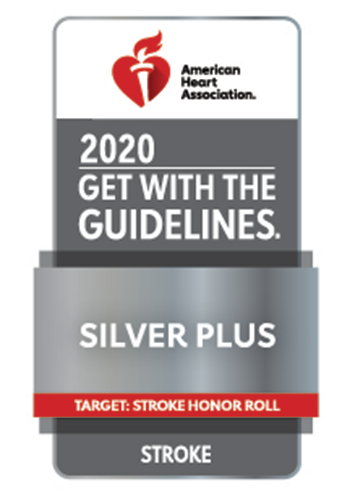
Blessing Hospital has received the American Heart Association/American Stroke Association’s Get With The Guidelines® Target: Stroke Honor Roll Silver Plus Quality Achievement Award. The award recognizes the hospital’s commitment to ensuring stroke patients receive the most appropriate treatment according to nationally recognized, research-based guidelines based on the latest scientific evidence, and has demonstrated the ability to deliver that level of care.
Blessing Hospital earned the Get with the Guidelines award by meeting specific quality achievement measures for the diagnosis and treatment of stroke patients at a set level for a designated period. These measures include evaluation of the proper use of medications and other stroke treatments aligned with the most up-to-date, evidence-based guidelines with the goal of speeding recovery and reducing death and disability for stroke patients. Before discharge, patients should also receive education on managing their health, get a follow-up visit scheduled, as well as other care transition interventions.
Blessing Hospital additionally received the association’s Target: StrokeSM Honor Roll award. To qualify for this recognition, hospitals must meet quality measures developed to reduce the time between the patient’s arrival at the hospital and treatment with the clot-buster tissue plasminogen activator, or tPA, the only drug approved by the U.S. Food and Drug Administration to treat ischemic stroke, the most common form of stroke caused by a blockage of blood flow to the brain.
“This is an honor for all Blessing Hospital caregivers who touch the lives of stroke patients and their loved ones,” said Maureen Kahn, RN, MHA, MSN, President/Chief Executive Officer, Blessing Health System and Blessing Hospital.
“It is a particular honor for the members of our multi-disciplinary Stroke Team,” Kahn continued. “The Blessing Stroke Team works to ensure every caregiver is educated in the use of evidenced-based clinical guidelines that improve patient outcomes. Then, using the tools and resources of the American Heart Association, the Blessing Stroke Team tracks and measures patient outcomes to continually identify opportunities to enhance the quality of our stroke care.”
How stroke care is delivered
Blessing is also a nationally-certified Primary Stroke Center. The hospital’s emphasis on quality stroke care begins in its Emergency Center, where most patients requiring stroke-related care come after a sudden onset of symptoms. Blessing caregivers stress the importance of calling 911 if symptoms of stroke occur, so that first responders can begin providing care immediately. Delays in stroke care can cause permanent damage to the brain and to a patient’s mobility.
From the emergency center, stroke patients might need care in Blessing’s critical care and/or medical/surgical nursing units. Finally, some stroke patients continue their recovery in Blessing's nationally accredited inpatient Rehabilitation Services unit to regain strength and mobility. Nearly 400 people came to Blessing Hospital for stroke-related care between May 2019 and April 2020.
“We are pleased to recognize Blessing Hospital for its commitment to stroke care,” said Lee H. Schwamm, M.D., national chairperson of the Quality Oversight Committee and Executive Vice Chair of Neurology, Director of Acute Stroke Services, Massachusetts General Hospital, Boston, Massachusetts. “Research has shown that hospitals adhering to clinical measures through the Get With The Guidelines quality improvement initiative can often see fewer readmissions and lower mortality rates.”
On average, someone in the U.S. suffers a stroke every 40 seconds and nearly 795,000 people suffer a new or recurrent stroke each year. According to the American Heart Association/American Stroke Association, stroke is the No. 5 cause of death and a leading cause of adult disability in the United States.
Signs and symptoms of stroke
Call 9-1-1 right away if you or someone else has a sudden onset of any of these symptoms:
- Numbness or weakness in the face, arm, or leg, especially on one side of the body
- Confusion, trouble speaking, or difficulty understanding speech
- Trouble seeing in one or both eyes
- Trouble walking, dizziness, loss of balance, or lack of coordination
- Severe headache with no known cause
To make stroke signs and symptoms easier to recall, remember the word FAST:
F is for face: Does the person’s face look uneven?
A is for arm: Does the person have one hanging lower than the other?
S is for speech: Does the person’s speech sound strange?
T is for time: Answer yes to any of these and act FAST, call 911.
For more information about stroke visit https://www.blessinghealth.org/stroke
